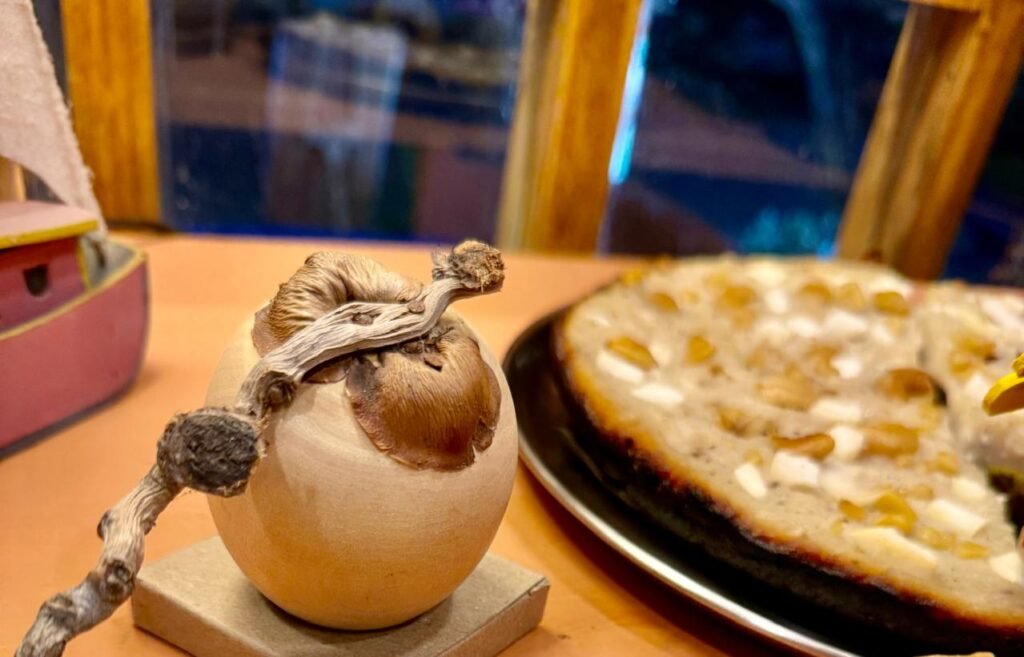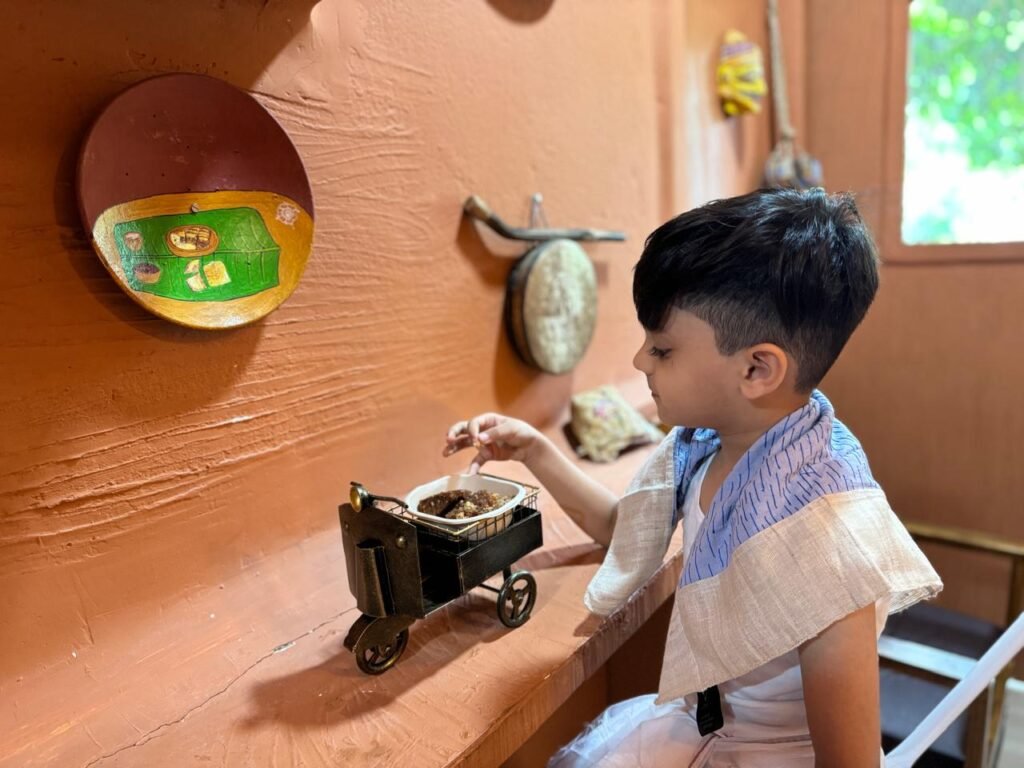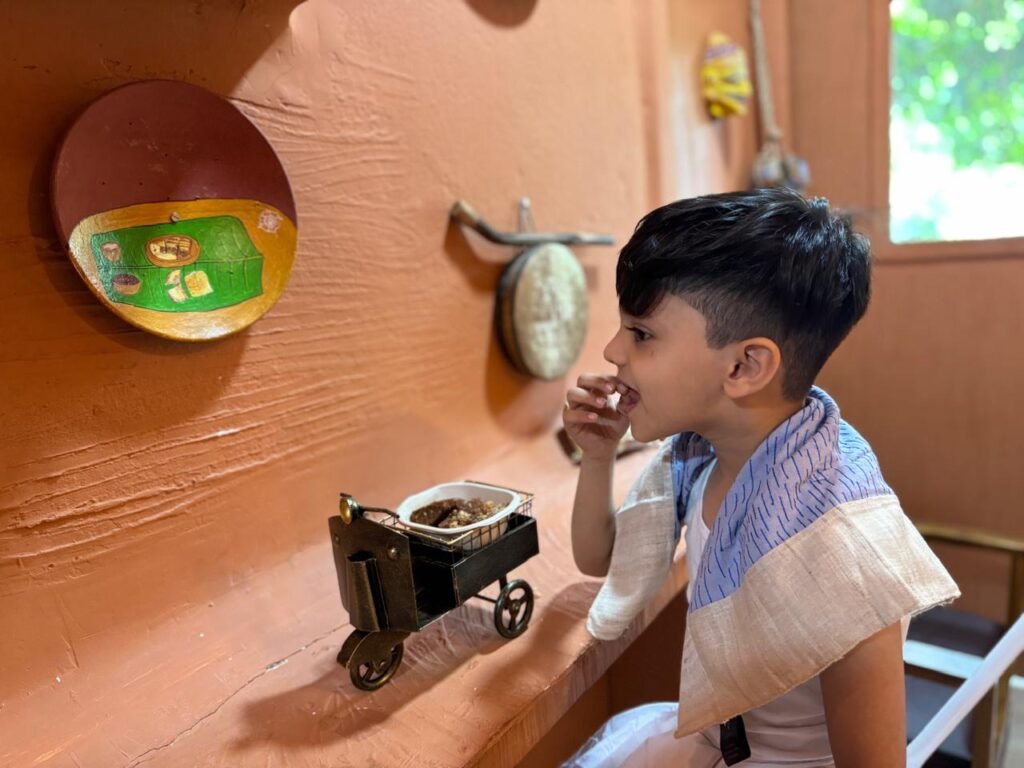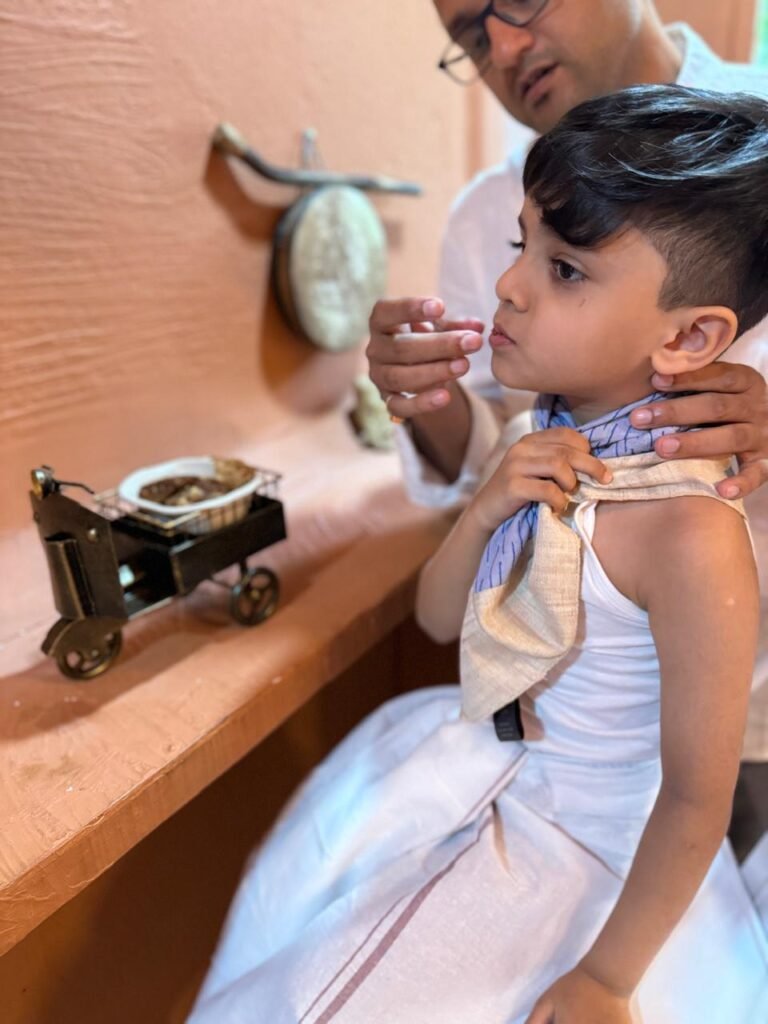Healthy poda-pitha / burnt- rice/other lintels, millets Veggies or fruits base cake-from-odisha
Different parts of India celebrate various festivals during the monsoon season. In Odisha, two festivals stand out during the rainy months of mid-June to August: Raja and Ratha Jatra. Both celebrations are incomplete without the renowned rice cake, poda pitha, which is characterized by its distinct charred bottom. In Odia, “poda” means burnt, and “pitha” refers to a category of cakes made from batters that can be fermented, semi-fermented, or unfermented, using rice, urad dal, semolina, or a combination of these grains and lentils. Specifically, for poda pitha, “poda” indicates the charred caramelization at the bottom of the cake, giving it a unique flavor and texture.

Pithas, made and perfected through centuries, are undoubtedly the cornerstones of Odia cuisine. It’s hard to imagine an Odia festival that does not include some kind of pitha in the celebratory menus.
The phone rings persistently as I struggle to answer it with batter-laden hands. “Next week, Monday, is Ratha Jatra,” Maa’s enthusiastic voice resonates through the speaker. “Ah! I checked it on the internet. Thanks, Maa!” I say, wiping a somewhat sticky paste of rice and urad dal off my fingers with a soiled kitchen towel. “I already made the batter for poda pitha,” I announce. “Oh, Google tells you everything now…” she begins, but I interrupt before she can finish her sentence, “But I still wait for your call.”
Ever since I moved away from home and started living on my own, Maa continues to remind me of all the festivals throughout the year. Makar Sankranti, Basant Panchami, Holi, Raja, Ratha Jatra, Ganesh Puja, Durga Puja, Diwali, and everything in between are constant reminders from her. As Hindu Indian festivals follow a lunar calendar, the dates aren’t fixed. For instance, Christmas is always on December 25, but Diwali does not always fall on the same date each year, although it typically occurs in October or November. Hindu Indian festivals follow something known as ‘tithi’, a specific alignment of planets and stars at particular times of different seasons. Thus, the Hindu festival calendar, known as pānji in Odia and panjika in Hindi, offers brand new dates every year.
The concept of monsoon doesn’t exist for me after moving to Canada, yet the festivals associated with the season remain unchanged. Maa’s reminders keep me abreast of the impending celebrations, nourishing the bonds that connect me to the place where I was born and raised.


**Lord Jagannath’s Favorite Dessert**
This year, on July 12, Odisha’s beloved Lord Jagannath will embark on his journey from his sacred abode, Shri Mandira in Puri, to the Gundicha Temple. Accompanied by his siblings, Subhadra and Balabhadra, they will ride upon wooden chariots drawn by thousands of devoted followers. After eight days of pampering at their aunt’s home, Gundicha Temple, they will begin their return journey to Shri Mandira. During this return trip, they will make a stop at Mausi Maa temple, where Lord Jagannath will enjoy his favorite dessert, poda pitha.
Lord Jagannath is known to love poda pitha. It is also believed that in an earlier incarnation as Shri Rām, he promised Rani Kaikeyi, his father’s second wife, that in a later birth he would come to her and savor this dessert. This promise was made to console a grief-stricken Kaikeyi, who realized her folly of sending Rām, along with his newlywed wife, Sita, and his brother, Lakshman, to live in the forests for fourteen years, when her own son, Bharat, confronted her. The Mausi Maa temple in Puri is believed to be Kaikeyi’s abode, and poda pitha symbolizes her motherly love for Shri Rām.

The traditional preparation of poda pitha reveals the effort and love that goes into making this cherished dessert.
The process begins with washing rice, which is then spread on thin linen or cotton cloths to be sun-dried. Once the rice is completely free of moisture, it is hand-pounded into a fine powder, known as chaula chuna, using a traditional tool called a dhenki. Fragrant and fiery spices such as black pepper, bay leaf, ginger, cardamom, and camphor are added to the powdered rice, along with sliced and grated coconut. Water is gradually incorporated to form a paste-like batter, which is then cooked on low heat to create a loose dough. This method is similar to making dough from non-glutinous flours using hot water.
The prepared dough is wrapped in leaves, typically sal or banana leaves, which are greased with ghee and stitched together with twigs. This package is then placed in an earthen vessel over a wood fire, with cinders placed on top to cook the dough slowly. The resulting steamed cake has a caramelized layer at the bottom, created by the burning and sticking of rice and jaggery. This burnt base is what gives the cake its name, poda pitha. To enhance its texture and flavor, soaked urad dal, ground on a stone mill, is often added to the batter.
The legend behind Kaikeyi’s poda pitha is open to interpretation, but it beautifully illustrates the queen’s desire to make amends for the injustice she inflicted upon Shri Rām by creating this special dessert for him.

**Puri and Poda Pitha**
The town of Puri, with its maze of narrow lanes, human-pulled rickshaws, and straying cows tussling for space, often maddens me, yet it continues to beckon me no matter where I live.
Perhaps it is the numbing serenity that creeps amidst the chaos of the lord’s temple and the many facets of history etched on its ancient walls. Maybe it’s the lord himself, with his deep, alluring eyes and ebony skin, that draws me in. Or perhaps it’s the unremitting waves of the Bay of Bengal, roaring and receding between ombré sunsets and sublime, moony nights. It could also be the eternal expanse of golden sands, eternally kissed by the surging foams of green and white, that holds me captive.
Perhaps it’s the train rides to Puri from childhood that twinkle in my mind like fireflies, or the bustling crowds eagerly pulling the lord and his siblings’ chariots during Ratha Jatra, the cart festival. Maybe it’s the beaches brimming with chaat and jhaal mudhi vendors in the evenings, or Baba’s narrations of lore about Jagannath, his voice clashing against the backdrop of the roaring sea.
And how could I forget the lord’s cuisine, which preserves the culinary art of Odisha amidst other art forms, attracting you like a magnet for a bite, only to leave you craving more. Like chenna poda, the burnt cheesecake of Odisha, poda pitha remains sought-after in the markets of Puri, known for serving some of the most delicious versions of this rice cake. There’s no doubt about it – if the lord adores it, then the best kind of pitha must be made in Puri.

Some weeks before Ratha Jatra, the festival of Rajaw is celebrated, marking the transition from rabi or dālua (summer rice) to khariph or biāli (autumn rice) cultivation. As farmers complete sowing rice for the new season, they take a hiatus from rice cultivation, allowing the earth, also revered as Bhoo Devi, to rejuvenate before the next growing season. During the four-day celebrations, the earth’s resting period is symbolized as her menstruation, serving as a reminder of the soil’s fertility that sustains us with food. Women, revered like the earth for their role in giving birth to new life, are honored during Rajaw.
In ancient times, with clay ovens, wooden hearths, and cooking and prep equipment mainly on the floor, kitchen activities placed a significant burden on the earth. During Rajaw, minimal cooking was done to allow the earth to rest, akin to women during their menstrual period. Thus, poda pitha, with its 4-5 day shelf life and nutritional benefits, served as a fitting dish for Rajaw, being not only delicious but also practical for the occasion.

Ratha Jatra, which celebrates the humanness of Lord Jagannath, bringing him to the streets to mingle with the masses, and Rajaw, which celebrates the glory of the Earth goddess, both have poda pitha intertwined in their rituals and practices.
While poda pitha’s connection with Rajaw bears pragmatism, its correlation to Ratha Jatra seems more mythical. Or is it? Rice is the soul of Odisha, so integral to the Odia diet that a meal is synonymous with bhāta or cooked rice. The phrase “Bhāta khāila ki,” meaning “did you eat rice,” implies “did you eat” or “did you have food” in general. Most festivals in Odisha revolve around rice and its various growing phases, involving not just one but many dishes made of rice. Poda Pitha is one such dish—a pitha with relatively longer shelf life, requiring minimal supervision as it slowly cooks on its own. It is practical and sustainable amidst the lull in cooking and farming during Rajaw.
Among the many rice-based desserts, Jagannath is believed to relish poda pitha the most—a cake deeply rooted in the state’s culinary history. It traces back to a time when Odisha was a vast kingdom comprising many tribes, including the Kalinga tribe. Secluded from the rest of India, this era predates conquerors like Ashoka by over 500 years. The traditional method of making this pitha is nothing short of a craft, with many historians attributing its origins to the ancient agrarian Odia tribes. These tribes are also credited with unfolding the festival of Rajaw, further highlighting their cultural significance in Odisha’s history.

The lord of the universe, Jagannath, is also revered as Sabara Dāru Debatā, the deity of the Sabara tribe—one of the oldest tribes in Odisha, where dāru means wood. The Jagannath cult, alongside the concurrent influence of Shivaism, Shaktism, and Vaishnavism, has symbiotically evolved with ancient Odisha, which was predominantly tribal. Each tribe specialized in farming, foraging, seafaring, trading, and other crafts. It’s plausible that spiritual and religious ideologies were also influenced by tribal or Atavik ways of worshipping divine powers, often represented by a log of wood, a post, or a stone pillar. Additionally, the tradition of offering prasad or food to the deities may have been inspired by tribal methods of cooking and serving food. Similar to dalma and pakhala, poda pitha likely made its journey from a tribal plate to the lord’s divine platter over time.
In modern kitchens, the cooking process of poda pitha has evolved with the advent of cooking appliances like ovens, while temples often adhere to traditional methods. At home, I begin by soaking rice and urad dal overnight and then grinding them into a slightly coarse batter in the morning using a blender.
I create a rustic batter by incorporating jaggery, black pepper, bay leaves, ginger, fennel, and coconut, which I then pour into a cake pan or tin. The batter is baked in an oven at 375°F for about 45 minutes, with the temperature increased to 400°F for the last 5 to 7 minutes to achieve a charred finish on the cake.
This traditional pitha tastes best with its rustic charm preserved. The spiciness of pepper and ginger harmonizes with the sweetness of jaggery and coconut, complementing the earthy flavors of rice and urad dal. A subtle aroma of fennel, bay leaves, ghee, and banana (or sal) leaves wafts from the cake, while sliced coconuts, fried cashews, and raisins add crunch and texture.
Poda pitha comes in various varieties, both savory and sweet. The one shared in this post is sweet, but savory versions, known as luni poda pitha (luni meaning salty in Odia), also exist. These savory versions incorporate vegetables like bottle gourd (laau poda pitha) or a mix of modern vegetables like carrots, cauliflower, and bell peppers, along with onions. They are typically served with savory curries or enjoyed on their own. Sweet variations use sugar or jaggery, coconut, nuts, and sometimes milk (khira poda pitha) or vegetables like pumpkin (boitalu or kakharu poda pitha).
Recipe:
Ingredients:
– 1 cup rice
– 1/2 cup split or whole hulled urad dal
– 1 cup jaggery
– 3/4 cup grated coconut
– 1-inch ginger, chopped and pounded
– 1 tsp crushed green cardamom pods and black peppercorns
– 1/4 tsp roughly crushed fennel
– 5-6 bay leaves
– 4 tbsp ghee (or oil – although oil will not taste the same)
– 1 tsp salt
– 1 tsp baking powder
– 1 tbsp brown sugar or jaggery powder to dust the cake pan
– 1/4 cup thinly sliced coconut
– 1/2 cup cashews and raisins
– 1-2 banana or sal leaves to wrap the batter (optional)
Method:
1. Soak rice and urad dal for 5-6 hours or overnight. In the morning, wash and drain the water. Then grind into a coarse paste with as little water as possible. Leave the batter to ferment for 3-4 hours. If you live somewhere extremely hot, you may leave it to ferment for an hour or so too.
2. In a pan, add 1 tsp ghee and roast the cashews and raisins until the raisins puff up. Keep aside.
3. Grease a baking pan or tin with some ghee, dust it with brown sugar or jaggery powder, tear 4 bay leaves and lay them on the pan, and keep it ready. If using banana or sal leaves, then line the cake tin with the leaves first.
4. Preheat oven to 375°F.
5. In a bowl, pour the fermented batter and add jaggery, grated coconut, half the sliced coconuts, remaining ghee, cardamom, pepper, fennel, remaining bay leaves torn to bits, salt, baking powder and half the cashews and raisins. Mix everything well.
6. Pour the batter into the cake tin and layer the top with remaining cashews, raisins and sliced coconuts to decorate.
7. Place the cake pan or tin in the oven and bake at 375°F for 40 minutes. For the next 5 minutes, bake at 390°F. Check for doneness by inserting a toothpick – it should come out clean. Else bake again for 5 minutes at 375°F.
8. Note: Baking at 390°F for 5 minutes is optional. I do it to ensure a char but I usually succeed without it too. Ovens can be different and their heating can vary. If you do this step, make sure you don’t cook the cake too long at this high temperature.
9. Let the cake cool completely before slicing.
Enjoy as is or with a hot cup of lembu cha or lemon tea! It stays well on the kitchen counter for 3-4 days.